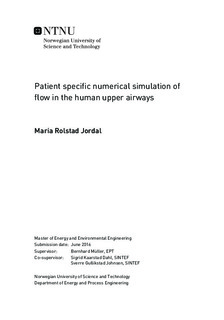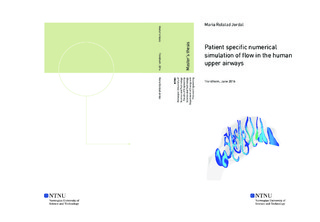| dc.description.abstract | In this master thesis, a patient specific computational fluid dynamics (CFD) \nomenclature{CFD}{Computational Fluid Dynamics} study has been done on the air flow in the human upper airways before and after surgical intervention. The patient studied is a 67 years old man who went from having moderate obstructive sleep apnea syndrome (OSAS), to close to none after intranasal surgery. The apnea-hypopnea index (AHI) was reduced from 23 to 5.7 as a result of the surgery.
From post- and pre-operatively computed tomography (CT) of the patient, a geometry of the human upper airways was generated by segmentation in ITK-SNAP 3.4.0. The paranasal sinuses were excluded, and the geometry was verified by a clinician. The model was further post-processed to eliminate digitalization artefacts. Because of a difference in the head positioning of the patient during pre- and post-operative CT, the pharynx and larynx looked rather different. To have two comparable models, the two geometries were combined so that the only difference before and after surgery is the nasal cavity.
Computational grids were generated in ANSYS Meshing \cite{ansys}, and a grid refinement study was done. The final grid consists of 3 mill. polyhedra grid cells. The flow was simulated as laminar at a flow rate of 250 ml/s (slow breathing) in ANSYS Fluent 16.2. Other assumptions includes steady state, incompressible flow, rigid walls, no slip at the wall and atmospheric pressure at the inlets.
The CFD results were post-processed in ANSYS CFD-post. After surgery, the flow was found to be more evenly distributed between the two nasal cavities and the flow pattern slightly changed. An increase in the pressure drop over the nasal cavity could be seen. For verification, the nasal resistance was compared with measured results from rhinomanometry and rhinoresistometry. The correspondence for the right nasal cavity was good post-operative, but remarkably lower for the other measures.
The high reduction in AHI measured clinically is not as clearly observed in the CFD results. The increase of flow in the left nasal may indicate that the patient has changed from mostly oral to nasal breathing after surgery. Because of the obstruction in the nose pre-operatively it is likely that the patient breathed mostly through his mouth, causing a backward movement of the tongue and a closing of the pharyngeal airway. Changing to nasal breathing as a result of the surgery would increase the pharyngeal volume and explain the great improvement in AHI. This hypothesis is not verified, but supported by clinicians. Further work is needed to gain more confidence in the results. | |

